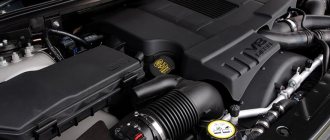Why is it difficult to start a diesel engine after a long stay in winter?
There can be many reasons for difficulty starting the engine at sub-zero temperatures. But they all have a common denominator - liquid. The colder it is outside, the harder it is for the engine to work. This applies most of all to cars running on diesel fuel (diesel fuel).
As the ambient temperature drops, diesel fuel begins to thicken . As a result, this leads to a change in composition. This usually leads to problems. Therefore, diesel fuel is divided into winter and summer. In cold weather, summer fruit tends to thicken and become waxy.
Thick diesel fuel cannot be pumped through the power system. To prevent this from happening, additives are added in the summer to prevent thickening at subzero temperatures. Those. In winter, gas stations sell diesel fuel that already contains additives. That’s why it’s called “winter”.
In addition, the battery also contains liquid. In cold weather, current generation is more difficult.
The cause of difficulty starting a diesel engine may be engine oil. It also thickens in cold weather.
To make it easier to start the engine and to ensure that it experiences minimal loads when driving in winter, read the article - choosing diesel oil.
How does a diesel car engine work?
Conventional wisdom holds that diesel engines produce a lot of noise, smell bad, and don't produce the required power. They are considered to be suitable only for trucks, vans and taxis. Possibly in the 1980s. everything was like that, but since then the situation has changed radically. Diesel engines and fuel injection controls have become much more sophisticated. In 1985 Almost 65,000 diesel cars were sold in the UK (approximately 3.5% of total cars sold). For comparison, in 1985 Only 5380 were sold (data probably for the US market).
The main parts of a diesel engine must be stronger than those of a gasoline engine.
Ignition. Sparks are not required for ignition, because the mixture ignites under compression.
Glow plugs. Heats up the combustion chamber during a cold start.
Many diesel engines are based on gasoline engines, but their main parts are more durable and can withstand high pressures.
Fuel enters the engine via a metering injection pump, which is usually attached to the side of the cylinder block. The system does not use electric ignition.
The main advantage of diesel engines over gasoline engines is reduced operating costs. Diesel engines are more efficient due to strong compression and lower fuel costs. Of course, diesel prices can vary, so a diesel car will cost you a lot if you live in an area with high diesel prices. In addition, such cars require maintenance less often, but oil changes are organized for them more often than for cars that run on gasoline.
How to start a diesel engine after sitting in cold weather?
Don’t panic right away if you were unable to start your car’s engine in the cold morning. If you turn the ignition key the first time and the engine does not start, wait a minute or two and repeat again. Ideally, the engine will start on the 3rd attempt maximum. If the 3rd has occurred, do not continue to start it under any circumstances, as you will significantly aggravate the situation. The starter may fail or the battery may be discharged.
Starting a diesel engine in winter is practically no different from a gasoline engine, but there are some nuances :
- Fully depress the clutch.
- Turn the ignition key until the instrument panel lights up and the spark plug indicator (in the form of a spring) goes out.
- If the car has been parked all night or in the cold for a long time, then you should turn on the headlights. This will allow the battery to warm up a little and make starting easier.
- Turn on the ignition and hold the key until the engine starts. But do not hold the key for more than 15 seconds.
- If the engine starts, lightly press the gas pedal. Let it run for a while at operating speed.
We recommend that you read the article - how much to heat a diesel engine in winter.
Warming up the spark plugs
Before starting a diesel engine in winter, you need to warm up the spark plugs . But how to do it correctly?
- Turn the ignition key until the indicators on the instrument panel come on.
- After the indicator in the form of a spring goes out and a characteristic click of the spark plug relay is heard (indicating that power is not supplied to the spark plugs), return the key to its original position.
- Wait 2-3 seconds and repeat this one more time steps 1 to 2.
- After this, you can start the engine.
As a result of this procedure, the spark plugs will warm up, this will be enough to guarantee starting the engine, provided that the battery is charged, the fuel is not frozen, and the spark plugs are in good condition.
If you fail to start a diesel engine in winter, you should use the methods described below.
Starting the engine by “lighting”
If your car's battery was weak and died in the cold. In such a situation, it is enough to ask for help from friends, acquaintances, or a neighbor in the parking lot that they have “lit up.” The procedure does not take much time, the main thing is that there are wires.
Owners of diesel cars - make sure that you always have cables in the trunk.
If you managed to start the diesel engine using this method, then you can go about your business in peace. But remember that you should not turn off the engine immediately after starting, because... The battery needs to be recharged , and for this you need to drive at least a couple of kilometers. But it is better if the engine runs for at least 30 minutes.
Application of additives and antigels
How to start a diesel engine in winter, when there is no one nearby who could “light it”? In this case, you will be saved by additives and anti-gels , of which there are many in any auto shop.
Diesel fuel, especially if it is summer fuel, can turn completely into paraffin from -10 degrees In this case, it will simply be impossible to start the engine.
It turns out that you use high-quality diesel fuel, which already contains special additives, or add them to the tank yourself. Diesel fuel at Russian gas stations is not of the best quality, so it is best to pour the additive into the tank at night, and in the morning you will start the diesel engine without any problems. Because the additive prevents paraffin from multiplying in the required volume.
Remember that it is better to fill in additives and antigels at zero temperature, or lower, so they will be much more useful. First, carefully read the instructions at what temperature and in what proportions you can add it.
How do diesel engines work?
Inlet
As the piston moves down the cylinder, the intake valve opens, admitting air.
Compression
When the piston reaches the bottom of the cylinder, the intake valve closes. The piston rises, compressing the air.
Ignition
Fuel is injected into the cylinder when the piston reaches the top base. This ignites the fuel and sets the piston in motion again.
Release
On the way back, the piston opens the exhaust valve and the exhaust gas exits the cylinder.
Four-stroke diesel and gasoline engines operate differently, even though they contain the same components. The main difference lies in the way the fuel is ignited and the resulting energy is managed.
In a gasoline engine, the mixture of air and fuel is ignited by a spark. In a diesel engine, the fuel is ignited by compressed air. In diesel engines, air is compressed on average at a ratio of 1/20, while for gasoline engines this ratio is on average 1/9. This compression greatly heats the air to a temperature sufficient to instantly ignite the fuel, so there is no need for sparks or other ignition methods when using a diesel engine.
Gasoline engines absorb a lot of air per piston stroke (the exact volume depends on the degree of opening of the throttle opening). Diesel engines always absorb the same volume, which depends on the speed, and the air duct is not equipped with a throttle. It is closed by one intake valve, and the engine does not have a carburetor or butterfly valve.
When the piston reaches the bottom of the cylinder, the intake valve opens. Under the influence of energy from the other pistons and momentum from the flywheel, the piston is sent to the upper base of the cylinder, compressing the air approximately twenty times.
Once the piston reaches the top base, a carefully measured volume of diesel fuel is injected into the combustion chamber. The heated air during compression instantly ignites the fuel, which expands during combustion and again sends the piston down, turning the crankshaft.
As the piston moves up the cylinder on the exhaust stroke, the exhaust valve opens, allowing the spent and expanded gases to exit into the exhaust pipe. At the end of the exhaust stroke, the cylinder is again ready for a new portion of fresh air.
What to do if diesel fuel is frozen?
How to start a diesel car in winter if the fuel is frozen? with diesel fuel containing a huge amount of paraffin . All that remains is to drain the diesel fuel and heat it to a temperature of 60 degrees, add an additive or anti-gel, mix and pour it back into the tank.
Add kerosene
Motorists who have impressive driving experience behind them prefer to add kerosene instead of additives. Essentially the effect is the same. In addition, it does not cause any harm to the fuel or the fuel system. It makes diesel fuel more liquid.
If you decide to add kerosene, then follow the proportions. Thus, for 100 liters of fuel, 30 liters of kerosene, no more.
Never add gasoline to diesel fuel. A serious mistake and misconception of many car owners. Gasoline does not have lubricating properties, unlike additives and kerosene. As a result, the car’s high-pressure fuel pump will pump diesel fuel “dry,” which can lead to breakdown. And this is not small money.
Dilute the fuel
Everyone knows that diesel, unlike gasoline, has two grades - summer and winter. The so-called Arctic fuel does not always appear at gas stations on time. Cold snaps occur. Then the question arises of how to start a diesel engine in winter on summer diesel fuel. Since its crystallization temperature is an order of magnitude higher, it freezes more easily. At minus 10 degrees it turns into paraffin.
It is simply impossible to start the engine with such fuel. What to do in such a situation? To do this, we will need to dilute the fuel in a tank with a special “winter” additive. The same is added at gas stations (in the same “summer fuel”), so this product should not be considered foreign and harmful to a diesel unit. It is recommended to pour the product in advance (for example, overnight). In the morning you will successfully start the engine on summer fuel. The product is inexpensive - about 400 rubles for a 500-ml bottle. But there are cases when diesel fuel crystallizes in the filters themselves.
And no additive will help here. How to start a diesel engine in cold weather? For this, third-party elements are used. Simply put, the filter is heated with a gas or kerosene burner. No need to worry - diesel fuel will not ignite from such a fire. The main thing is not to get on plastic elements that can melt. This is the surest way to start the engine in any cold weather.
Additives, replacing the fuel filter, heating the tank
Most often, a fully operational diesel engine cannot be started in the cold precisely because the diesel fuel in the diesel engine has frozen. Unprepared diesel fuel thickens, becomes cloudy and waxes in the fuel tank, filters and lines of diesel engines even at relatively low negative temperatures.
We also recommend reading the article on choosing an antigel. From this article you will learn about the main criteria in the process of selecting additives for diesel fuel, as well as about testing products of this type on the market.
A common reason why a diesel engine will not start in winter is a clogged fuel filter. The diesel engine fuel filter itself consists of thick paper, which is completely clogged with paraffin and the throughput is lost. Experienced owners of diesel cars always have a spare fuel filter in the trunk. Sometimes just replacing it is enough to successfully start a diesel car in winter after an overnight stay.
There are also diesel cars with a fuel filter without heating. On such machines, the filter element can freeze right on the highway when there is strong blowing of cold air, even if high-quality winter diesel fuel is poured in. Third-party installation of heating the fuel filter and fuel line solves this problem.
Tips for the future
Of course, it is best to prevent these cases. For this we recommend:
- Leave the car in the garage. Ideally, the highest and most stable air temperature is found in underground types of premises. But if you don’t have such a garage, try to insulate the gate of a regular one. A car stored in such a room is not only protected from fuel freezing, but is also not exposed to external factors (in summer, rain and direct ultraviolet rays).
- Always refuel with quality fuel. Of course, refueling offers at cheap gas stations seem tempting, but in winter it makes sense to look for stations only from large chains. As for diesel fuel specifically, all gas stations from December to February must sell only the winter grade of diesel fuel, which does not freeze at a temperature of -20 degrees Celsius.
- If possible, store the battery at home. Even if your car is stored in a garage, it still makes sense to remove the battery at night. A warm battery will ensure reliable engine starting even at the lowest temperatures. And before starting a diesel engine in cold weather, do not neglect to check the battery charge. If it is less than 12.5 Volts, connect it to the charger for 1-2 hours. In cold weather, the battery charge should be slightly higher than normal, that is, about 12.5-13.5 V.
So, we found out how to properly start a diesel engine in winter. We hope you find the tips above helpful. Good luck on the roads!











